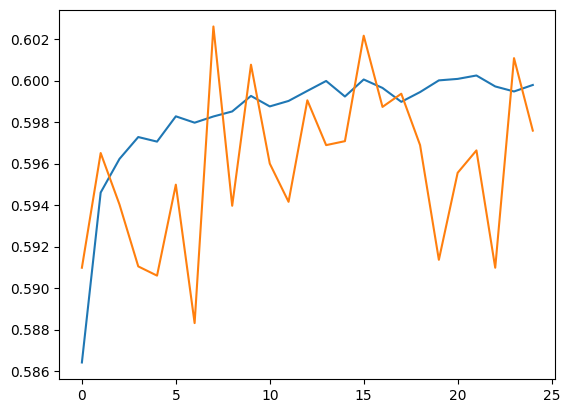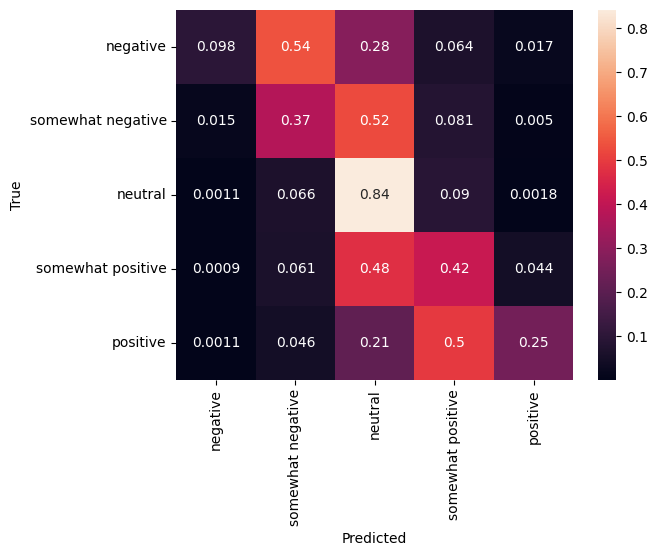 TensorFlow.org'da görüntüleyin TensorFlow.org'da görüntüleyin |  Google Colab'da çalıştırın Google Colab'da çalıştırın |  GitHub'da görüntüle GitHub'da görüntüle |  Not defterini indir Not defterini indir |  TF Hub modeline bakın TF Hub modeline bakın |
TF-Hub yeniden kullanılabilir kaynaklarında paketlenmiş pay makine öğrenme uzmanlığı, özellikle önceden eğitilmiş modülleri bir platformdur. Bu öğreticide, makul bir temel doğrulukla basit bir duygu sınıflandırıcıyı eğitmek için bir TF-Hub metin gömme modülü kullanacağız. Daha sonra tahminleri Kaggle'a göndereceğiz.
TF-Hub ve hassasiyeti geliştirmek için daha ileri adımlar metin sınıflandırma ile ilgili daha ayrıntılı bir eğitici için bir göz atın TF-Hub ile Metin sınıflandırma .
Kurmak
pip install -q kaggle
import tensorflow as tf
import tensorflow_hub as hub
import matplotlib.pyplot as plt
import numpy as np
import pandas as pd
import seaborn as sns
import zipfile
from sklearn import model_selection
Bu öğretici Kaggle bir veri seti kullanarak olacağından, bunun gerektirir bir API Jetonu oluşturarak sizin Kaggle hesabının ve CoLab ortamına yükleyerek.
import os
import pathlib
# Upload the API token.
def get_kaggle():
try:
import kaggle
return kaggle
except OSError:
pass
token_file = pathlib.Path("~/.kaggle/kaggle.json").expanduser()
token_file.parent.mkdir(exist_ok=True, parents=True)
try:
from google.colab import files
except ImportError:
raise ValueError("Could not find kaggle token.")
uploaded = files.upload()
token_content = uploaded.get('kaggle.json', None)
if token_content:
token_file.write_bytes(token_content)
token_file.chmod(0o600)
else:
raise ValueError('Need a file named "kaggle.json"')
import kaggle
return kaggle
kaggle = get_kaggle()
Başlarken
Veri
Biz çözmeye çalışacağı Film Eleştirileri üzerine Duygu Analizi Kaggle gelen görev. Veri seti, Rotten Tomatoes film incelemelerinin sözdizimsel alt sözcüklerinden oluşur. Görev 1'den 5'e kadar ölçekte negatif veya pozitif olarak ifadeler nitelemektedir.
Sen gerekir rekabet kurallarını kabul verileri indirmek için API kullanmadan önce.
SENTIMENT_LABELS = [
"negative", "somewhat negative", "neutral", "somewhat positive", "positive"
]
# Add a column with readable values representing the sentiment.
def add_readable_labels_column(df, sentiment_value_column):
df["SentimentLabel"] = df[sentiment_value_column].replace(
range(5), SENTIMENT_LABELS)
# Download data from Kaggle and create a DataFrame.
def load_data_from_zip(path):
with zipfile.ZipFile(path, "r") as zip_ref:
name = zip_ref.namelist()[0]
with zip_ref.open(name) as zf:
return pd.read_csv(zf, sep="\t", index_col=0)
# The data does not come with a validation set so we'll create one from the
# training set.
def get_data(competition, train_file, test_file, validation_set_ratio=0.1):
data_path = pathlib.Path("data")
kaggle.api.competition_download_files(competition, data_path)
competition_path = (data_path/competition)
competition_path.mkdir(exist_ok=True, parents=True)
competition_zip_path = competition_path.with_suffix(".zip")
with zipfile.ZipFile(competition_zip_path, "r") as zip_ref:
zip_ref.extractall(competition_path)
train_df = load_data_from_zip(competition_path/train_file)
test_df = load_data_from_zip(competition_path/test_file)
# Add a human readable label.
add_readable_labels_column(train_df, "Sentiment")
# We split by sentence ids, because we don't want to have phrases belonging
# to the same sentence in both training and validation set.
train_indices, validation_indices = model_selection.train_test_split(
np.unique(train_df["SentenceId"]),
test_size=validation_set_ratio,
random_state=0)
validation_df = train_df[train_df["SentenceId"].isin(validation_indices)]
train_df = train_df[train_df["SentenceId"].isin(train_indices)]
print("Split the training data into %d training and %d validation examples." %
(len(train_df), len(validation_df)))
return train_df, validation_df, test_df
train_df, validation_df, test_df = get_data(
"sentiment-analysis-on-movie-reviews",
"train.tsv.zip", "test.tsv.zip")
Split the training data into 140315 training and 15745 validation examples.
train_df.head(20)
Model Eğitimi
class MyModel(tf.keras.Model):
def __init__(self, hub_url):
super().__init__()
self.hub_url = hub_url
self.embed = hub.load(self.hub_url).signatures['default']
self.sequential = tf.keras.Sequential([
tf.keras.layers.Dense(500),
tf.keras.layers.Dense(100),
tf.keras.layers.Dense(5),
])
def call(self, inputs):
phrases = inputs['Phrase'][:,0]
embedding = 5*self.embed(phrases)['default']
return self.sequential(embedding)
def get_config(self):
return {"hub_url":self.hub_url}
model = MyModel("https://tfhub.dev/google/nnlm-en-dim128/1")
model.compile(
loss = tf.losses.SparseCategoricalCrossentropy(from_logits=True),
optimizer=tf.optimizers.Adam(),
metrics = [tf.keras.metrics.SparseCategoricalAccuracy(name="accuracy")])
history = model.fit(x=dict(train_df), y=train_df['Sentiment'],
validation_data=(dict(validation_df), validation_df['Sentiment']),
epochs = 25)
Epoch 1/25 4385/4385 [==============================] - 16s 3ms/step - loss: 1.0237 - accuracy: 0.5869 - val_loss: 1.0023 - val_accuracy: 0.5870 Epoch 2/25 4385/4385 [==============================] - 15s 3ms/step - loss: 0.9995 - accuracy: 0.5941 - val_loss: 0.9903 - val_accuracy: 0.5952 Epoch 3/25 4385/4385 [==============================] - 15s 3ms/step - loss: 0.9946 - accuracy: 0.5967 - val_loss: 0.9811 - val_accuracy: 0.6011 Epoch 4/25 4385/4385 [==============================] - 15s 3ms/step - loss: 0.9924 - accuracy: 0.5971 - val_loss: 0.9851 - val_accuracy: 0.5935 Epoch 5/25 4385/4385 [==============================] - 15s 3ms/step - loss: 0.9912 - accuracy: 0.5988 - val_loss: 0.9896 - val_accuracy: 0.5934 Epoch 6/25 4385/4385 [==============================] - 15s 3ms/step - loss: 0.9896 - accuracy: 0.5984 - val_loss: 0.9810 - val_accuracy: 0.5936 Epoch 7/25 4385/4385 [==============================] - 15s 3ms/step - loss: 0.9892 - accuracy: 0.5978 - val_loss: 0.9845 - val_accuracy: 0.5994 Epoch 8/25 4385/4385 [==============================] - 15s 3ms/step - loss: 0.9889 - accuracy: 0.5996 - val_loss: 0.9772 - val_accuracy: 0.6015 Epoch 9/25 4385/4385 [==============================] - 15s 3ms/step - loss: 0.9880 - accuracy: 0.5992 - val_loss: 0.9798 - val_accuracy: 0.5991 Epoch 10/25 4385/4385 [==============================] - 15s 3ms/step - loss: 0.9879 - accuracy: 0.6002 - val_loss: 0.9869 - val_accuracy: 0.5935 Epoch 11/25 4385/4385 [==============================] - 15s 3ms/step - loss: 0.9878 - accuracy: 0.5998 - val_loss: 0.9790 - val_accuracy: 0.5985 Epoch 12/25 4385/4385 [==============================] - 14s 3ms/step - loss: 0.9871 - accuracy: 0.5999 - val_loss: 0.9845 - val_accuracy: 0.5964 Epoch 13/25 4385/4385 [==============================] - 15s 3ms/step - loss: 0.9871 - accuracy: 0.6001 - val_loss: 0.9800 - val_accuracy: 0.5947 Epoch 14/25 4385/4385 [==============================] - 15s 3ms/step - loss: 0.9873 - accuracy: 0.6001 - val_loss: 0.9810 - val_accuracy: 0.5934 Epoch 15/25 4385/4385 [==============================] - 14s 3ms/step - loss: 0.9865 - accuracy: 0.5988 - val_loss: 0.9824 - val_accuracy: 0.5898 Epoch 16/25 4385/4385 [==============================] - 15s 3ms/step - loss: 0.9865 - accuracy: 0.5993 - val_loss: 0.9779 - val_accuracy: 0.5974 Epoch 17/25 4385/4385 [==============================] - 15s 3ms/step - loss: 0.9866 - accuracy: 0.5991 - val_loss: 0.9785 - val_accuracy: 0.5972 Epoch 18/25 4385/4385 [==============================] - 15s 3ms/step - loss: 0.9863 - accuracy: 0.6001 - val_loss: 0.9803 - val_accuracy: 0.5991 Epoch 19/25 4385/4385 [==============================] - 16s 4ms/step - loss: 0.9863 - accuracy: 0.5996 - val_loss: 0.9773 - val_accuracy: 0.5957 Epoch 20/25 4385/4385 [==============================] - 15s 3ms/step - loss: 0.9862 - accuracy: 0.5995 - val_loss: 0.9744 - val_accuracy: 0.6009 Epoch 21/25 4385/4385 [==============================] - 15s 3ms/step - loss: 0.9861 - accuracy: 0.5997 - val_loss: 0.9787 - val_accuracy: 0.5968 Epoch 22/25 4385/4385 [==============================] - 15s 3ms/step - loss: 0.9855 - accuracy: 0.5998 - val_loss: 0.9794 - val_accuracy: 0.5976 Epoch 23/25 4385/4385 [==============================] - 14s 3ms/step - loss: 0.9861 - accuracy: 0.5998 - val_loss: 0.9778 - val_accuracy: 0.5966 Epoch 24/25 4385/4385 [==============================] - 15s 3ms/step - loss: 0.9860 - accuracy: 0.5999 - val_loss: 0.9831 - val_accuracy: 0.5912 Epoch 25/25 4385/4385 [==============================] - 14s 3ms/step - loss: 0.9858 - accuracy: 0.5999 - val_loss: 0.9780 - val_accuracy: 0.5977
Tahmin
Doğrulama seti ve eğitim seti için tahminler çalıştırın.
plt.plot(history.history['accuracy'])
plt.plot(history.history['val_accuracy'])
[<matplotlib.lines.Line2D at 0x7f62684da090>]

train_eval_result = model.evaluate(dict(train_df), train_df['Sentiment'])
validation_eval_result = model.evaluate(dict(validation_df), validation_df['Sentiment'])
print(f"Training set accuracy: {train_eval_result[1]}")
print(f"Validation set accuracy: {validation_eval_result[1]}")
4385/4385 [==============================] - 14s 3ms/step - loss: 0.9834 - accuracy: 0.6007 493/493 [==============================] - 1s 2ms/step - loss: 0.9780 - accuracy: 0.5977 Training set accuracy: 0.6006770730018616 Validation set accuracy: 0.5976500511169434
karışıklık matrisi
Bir başka ilginç istatistik, özellikle çok sınıflı sorunlar için vardır karışıklık matrisi . Karışıklık matrisi, doğru ve yanlış etiketlenmiş örneklerin oranının görselleştirilmesini sağlar. Sınıflandırıcımızın ne kadar önyargılı olduğunu ve etiketlerin dağılımının anlamlı olup olmadığını kolayca görebiliriz. İdeal olarak, tahminlerin en büyük kısmı köşegen boyunca dağıtılmalıdır.
predictions = model.predict(dict(validation_df))
predictions = tf.argmax(predictions, axis=-1)
predictions
<tf.Tensor: shape=(15745,), dtype=int64, numpy=array([1, 1, 2, ..., 2, 2, 2])>
cm = tf.math.confusion_matrix(validation_df['Sentiment'], predictions)
cm = cm/cm.numpy().sum(axis=1)[:, tf.newaxis]
sns.heatmap(
cm, annot=True,
xticklabels=SENTIMENT_LABELS,
yticklabels=SENTIMENT_LABELS)
plt.xlabel("Predicted")
plt.ylabel("True")
Text(32.99999999999999, 0.5, 'True')

Aşağıdaki kodu bir kod hücresine yapıştırıp çalıştırarak tahminleri kolayca Kaggle'a gönderebiliriz:
test_predictions = model.predict(dict(test_df))
test_predictions = np.argmax(test_predictions, axis=-1)
result_df = test_df.copy()
result_df["Predictions"] = test_predictions
result_df.to_csv(
"predictions.csv",
columns=["Predictions"],
header=["Sentiment"])
kaggle.api.competition_submit("predictions.csv", "Submitted from Colab",
"sentiment-analysis-on-movie-reviews")
Gönderdikten sonra, afiş kontrol nasıl yaptığını görmek için.

